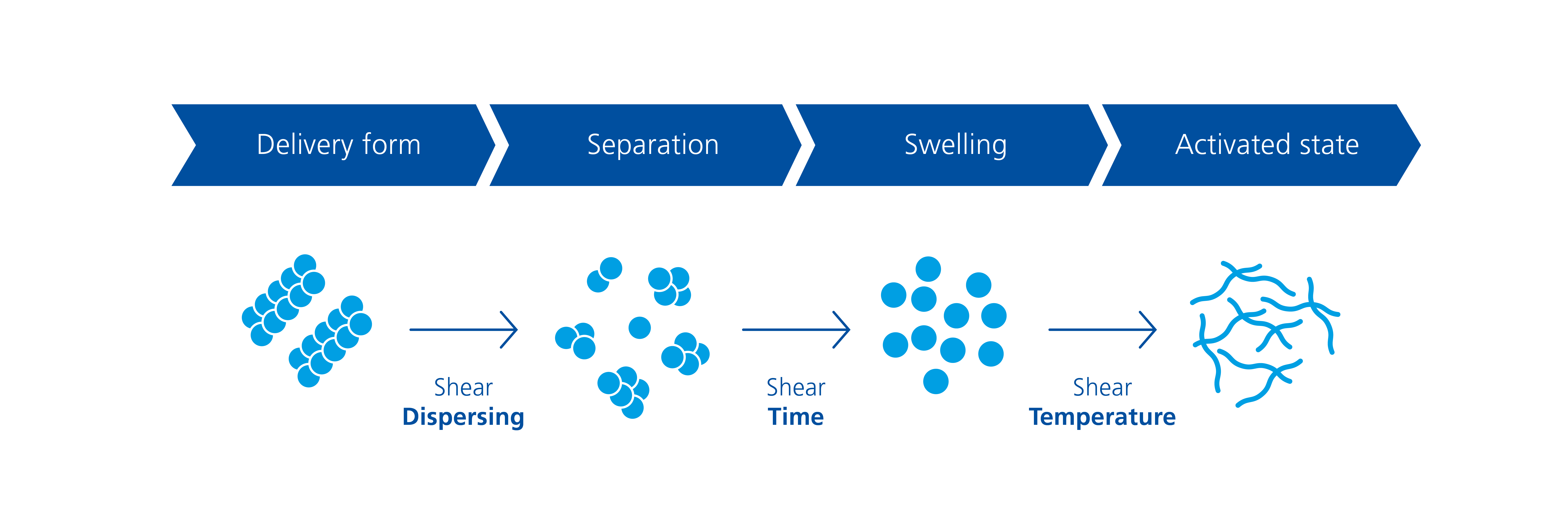- Additives
- Instruments

Diamides and castor oil derivatives are organic rheology additives in powder form which are widely used in the market. They are mainly used to achieve high viscosities (in-can viscosity) and high film thicknesses and are therefore particularly suitable for the formulation of thick film coatings, such as in heavy-duty corrosion protection, as well as adhesives and sealants.
Both diamides and castor oil derivatives can be present as powders in different particle sizes or particle size distributions and chemical compositions. In order to achieve a rheological effect, an activation step is first required. For this purpose, it is necessary to swell the powder particles as good as possible. Factors influencing swelling include the polarity of the formulation (binder, solvent), the temperature, the shear forces applied and the dispersion time. The best rheological effectiveness is achieved when the active substance is completely swollen without changing to a dissolved state.
A major difference between the two product classes is their melting point, as different activation temperatures are required according to it.
It is characteristic of castor oil derivatives, due to their low melting point, that they require both a minimum temperature for activation and the observance of a maximum temperature which must not be exceeded. If the minimum temperature is not reached, the ideal effectiveness is not achieved and seeding and gloss reduction may occur in the application system. When the maximum temperature is reached, the active substance is completely dissolved and the rheological effectiveness is no longer given; when the formulation is subsequently cooled down without stirring, seeds may form.
In contrast to castor oil derivatives, diamides behave much less critically: Due to their significantly higher melting point, the risk of exceeding the maximum temperature during incorporation no longer exists in practice; processing is thus considerably simplified. However, they require a significantly higher minimum temperature to achieve complete swelling of the powder.
To facilitate handling and processing, pre-activated diamide pastes are also offered on the market, which can be used as postadditives without temperature control. The disadvantage of these products is their high solvent content (80-90 %), which does not allow environmentally friendly formulation, and the significantly higher price compared to powder products. Due to their pronounced pseudoplastic flow behavior, diamides and castor oil derivatives are always used if a good price/performance ratio is required to achieve high in-can viscosities and film thicknesses. Due to their 100 % delivery form (unless used as pastes), the products are particularly suitable for the formulation of solvent-free systems.
Castor oil derivatives are preferred in non-polar, aliphatic systems where price is the primary concern and where people are familiar with the difficult handling and processing.
Diamides, on the other hand, can be used more universally in a wider polarity range, allow better storage stability of the application system (even at higher temperatures) and have less influence on intercoat adhesion.
Castor oil derivatives and diamide waxes are based on a combination of hydrogen bonding and van der Waals interactions. In the case of diamides, it is postulated that primary fibers are formed due to hydrogen bonds between the amide functions of the molecules. These fibers then combine to form fiber bundles and networks due to hydrogen bonding of the hydroxyl groups and van der Waals interactions, thus creating a gel structure.

If you delete your search history, all your previous searches will be deleted permanently.